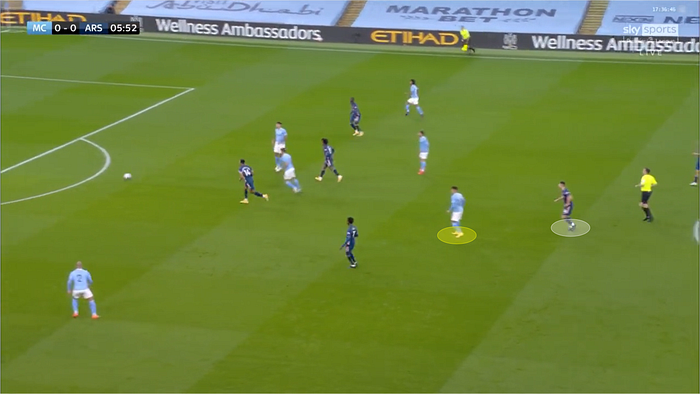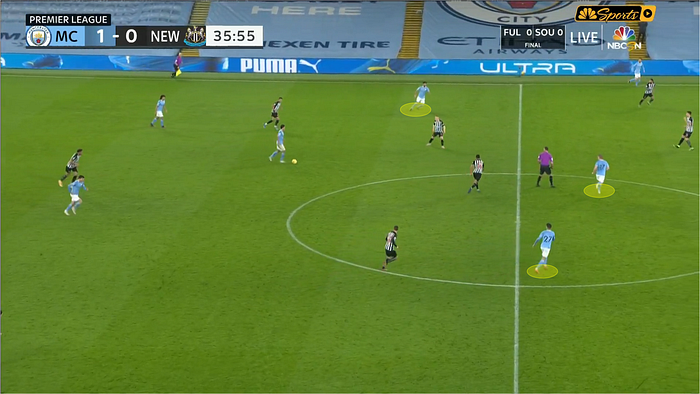How Manchester City are improving in possession

“One of the main things that I remember from being young was a piano. In the middle of the living room, because my father was playing piano. A lot, a lot. He was playing classical music. One piece of classical music, it’s like sentences. It’s like you’re reading — it’s like a poem. You have the first sentence, the second, the third, etc. And when you want to repeat it to make it perfect, you take one sentence and repeat it a million times until it’s just a perfection. It’s the same with tennis. Exactly the same. Practice a million times, until it’s perfect.” — Patrick Mouratoglou, Serena Williams’ coach.
The Australian Open, French Open, Wimbledon, US Open and Olympic Gold Medal winning coach might have been talking about piano and tennis, but this applies to all aspects of life. Nonetheless, football.
Manchester City’s triumph against Arsenal last October was based around controlling the Gunners and nullifying their build-up. It worked, and as interestingly was their shape in possession.
The shape was similar to a 3–3–1–3 with Joao Cancelo moving inside as a a right sided midfielder. This inside positioning from Cancelo forced Saka infield, resulting in Arsenal keeping the 4–3–3 shape in both offensive and defensive phases. City’s idea on the day was to isolate Riyad Mahrez against Kieran Tierney.

In the first example here you can see Granit Xhaka’s alertness to Cancelo’s narrow positioning as the ball goes back to Ederson.

Once the Manchester City attack resets, both Dani Ceballos and Xhaka are tracking Bernardo Silva and Cancelo respectively.

Leaving space behind them that could be exploited by Raheem Sterling, City’s 3–1 shape in midfield gave them an extra man against Arsenal’s midfield. The important thing to note here though, is that Bukayo Saka now shifts his focus entirely to Cancelo who is going inside the pitch rather than out.

As a result of the space Sterling had, Nathan Ake managed to find him easily and Saka’s inside positioning to track Cancelo left Mahrez completely free out wide. Mahrez created a heading chance for Sergio Aguero from this position, but the Argentine’s header went over the bar.

City’s midfield diamond was constantly stretching Arsenal’s midfield to create space. Aiding that was Aguero’s movement in and out of the midfield. Again, Sterling was found comfortably…..

…..then Cancelo’s run in behind Saka forced Tierney to go inside leaving Mahrez free.

City reached the state they wanted to be in. Unluckily for them, Mahrez couldn’t score from this chance.

Isolating Mahrez was just the tip of the iceberg, an opponent dependent tweak to give Manchester City an edge. Beneath that was City’s three principles in possession:
- Two wide men high up the pitch to stretch the opponent
- Overloading the midfield to provide constant passing options
- Any player can attack the central forward space if free and another will cover him

These principles have guided City throughout their recent improvement in possession. Repeating them till they are perfected.
However, City have also added certain tweaks depending on the opponent such as isolating Mahrez against the opponent’s full back as seen above.
In the game against Newcastle United, the 3–1–3–3 shape in possession provided City with 3 creative stations to find runners in behind Newcastle’s defence rather than being solely dependent on Kevin De Bruyne.

Cancelo proved to be the other creator as Newcastle’s midfield were all over De Bruyne while simultaneously worrying about Ilkay Gundogan’s runs.

Here, the wide presence of Sterling threatened Matt Ritchie and Miguel Almiron forcing both to retreat, leaving Cancelo free.

Normally, City wouldn’t have another creator here but by adhering to the three principles and tweaking the shape into the more attacking 3–1–3–3, Cancelo was there to play Sterling through on goal.

A pass that eventually ended in Sterling finding the other midfielder (Gundogan) running into the box to make it 1–0.

City made sure that there was always more than one creator in between the lines, even when dropping to help the build up.

Such that when De Bruyne makes a run into the box here….

….there’s still another creator centrally to create a chance rather than City circulating and waiting for De Bruyne to reset. Here, Cancelo again managed to find Sterling behind Newcastle’s defence but the angle was too small for the English striker to score.

In a world where having one De Bruyne seems unfair, Cancelo shape-shifted to be the second. Here, you can see the three creators are set, in between the lines.

Once one drops to receive and moves the Newcastle players towards him….

…..the other is free to create after receiving the ball. De Bruyne found De Bruyne, and only a De Bruyne cross makes you De Bruyne. Cancelo found Aguero with a De Bruyne cross at the far post, and only Karl Darlow stopped this fluid attack from ending into the net.

For all the talk about the other creators, their presence also helped free De Bruyne. Here, Cancelo’s positioning denies Newcastle’s midfield from going out and facing the Belgian. As a result, De Bruyne found Aguero’s run with a sublime pass taking out nine Newcastle players in the process, but again Darlow was at the rescue for Newcastle.

A similar scenario could be seen earlier on in the game. Sterling, who switched positions momentarily with Cancelo was now playing as a midfielder, and alongside Gundogan occupied the eyes and thoughts of Newcastle’s midfield. Lurking in the shadows though was De Bruyne.

Which meant that once he got the ball, he had time to adjust and pick his pass without any pressure from the opponent’s midfield. Here, he managed to find Sterling behind Newcastle’s defence but the attack ended in a corner-kick.

The following tweak was at Old Trafford and it was mainly revolving around Gundogan.
In a more of a lopsided 3–3–1–3, De Bruyne dropped regularly to help the build up and create space in Manchester United’s midfield.

Space which was often attacked by Cancelo, dragging Scott McTominay inside and leaving Aaron Wan-Bissaka in a dilemma. Staying wide would leave a hole in the defensive line for Gundogan to attack, and staying tight would leave Phil Foden free out wide.

It was Gundogan’s runs that destabilized Manchester United. Keeping Wan-Bissaka occupied…

….so that Foden would have more time on the ball. Here, Gundogan was offside, denying City an early opener.

In another attack McTominay was initially keeping tabs on Gundogan as City were in their lopsided shape.

Once De Bruyne dragged Fred over however, Cancelo attacked the space. Forcing McTominay to change his attention and leave Wan-Bissaka in the same dilemma. Will it be Gundogan or Foden?

It was Gundogan and notably Victor Lindelof pushed out to close down the Cancelo option for City. But Fernandinho chose a different option at all, a ball behind the defence for the lurking De Bruyne near the touchline.

Now the domino effect comes into practice. Foden is completely free at the far post because Wan-Bissaka chose to go with Gundogan. A better ball from De Bruyne certainly would have given Manchester City a high probability chance of scoring.


The overload City kept having in their right channel, kept tilting Manchester United’s midfield and Gundogan kept making those runs.

It was only the final pass that was missing to find Foden at the far post. Again, De Bruyne uncharacteristically was unable to find Foden.

The one time he did, Foden was slightly offside. But De Bruyne managed to find Foden because of Gundogan’s run which perplexed Wan-Bissaka yet again.

Foden was slightly offside but if he wasn’t, there were three City players in goal scoring opportunities.

Throughout all these snippets, the three principles are applied. They are the basis to Manchester City’s improvement in possession. The tweaks meanwhile are the cherry on the top, adhering to the principles while dismantling the opponent.
Match after match, City’s moves are repeated to perfection.
So what’s better than perfect?
“It’s automatic.” — Patrick Mouratoglou.
